Ames W.F., Harrel E.M., Herod J.V. (editors). Differential Equations with Applications to Mathematical Physics
Подождите немного. Документ загружается.


60
J.-M.
Combes
Floquet operator
(or
more generally the quasi-energy operator) is
related to quantum stability whereas
a
continuous spectrum implies
unbounded growth of the energy. The need for quantitative refine-
ments of these general connections appeared in the last ten years with
the investigation
of
models in solid state physics exhibiting “extrmr-
dinary spectra” (in the terminology of Avron and Simon
[l])
like
dense point spectrum
or
continuous singular spectrum supported on
Cantor sets. Such models reveal in addition “unusual” dynamical be-
haviours
as
opposed to what is “usual” for well-behaved potentials;
to be more precise let
with
$t
the solution
of
the Schrodinger equation with
$t=o
=
$0
and
A
a self-adjoint operator such that
$t
E
D(A)
Vt
E
R
if
$0
does. For
A
=
1XI2,
the mean square displacement, one thinks of “ordinary”
dynamics
as
either the localisation regime where
<
1XI2(t)
><
C
Vt
or
the ballistic regime where
1XI2(t)
>N
Ct2(t
-,
oo),
which are
supposed to correspond respectively to discrete
or
absolutely con-
tinuous spectrum from our experience of well-behaved (locally and
asymptotically) potentials (although this has no general mathemat-
ical ground). On the other hand it is well-known that intermediate
behaviours between these two exist.
For
example in the hierarchical
models considered by Jona-Lasinio et
al.
[9]
one has
<
IX12(t)
>N
C(Logt)o
for some
p
>
0;
but more generally the importance
of
these intermediate regimes is due to the relation between the “diffu-
sion constant”:
and static conductivity. Without going into the details of this connec-
tion (see e.g.
[4], [15])
let us just mention that one electron models of
metals (resp. insulators) should have
0
<
D+o
<
00
(resp.
D+o
=
0).
Thus in particular diffusive behaviour is the rule in models
of
con-
ducting media and one would like to know which type of spectra is
responsible for this. Clearly connections between these “extrmrdi-
nary” spectral and dynamical properties go beyond the mere
RAGE
theorems which might not even provide the right intuition. For ex-
ample think
of
the naive conjecture that
D+o
=
0
corresponds to

Quantum Dynamics and Spectral Properties
61
a
pure point spectral measure for
$0;
although it is correct that
<
IXI2(t)
><
C
Vt
implies that
$0
has no continuous component
the only general result about the converse is
a
recent one by B. Si-
mon [12] stating that in this last case lim
-
<
IX12(t)
>=
0
which
is far from the expected answer
Q,j0
=
0.
One
of
the reasons why
our intuition might be misleading is that unusual spectra like dense
pure point
or
singular continuous are very unstable. As shown e.g. by
Simon and Wolff [14] and Howland [6] even
a
rank one perturbation
with arbitrary small norm can induce
a
transition from one type to
the other. On the other hand one does not expect that the dynamics
should be strongly affected by such perturbations. Thus if one be-
lieves in this last argument any "extraordinary" dynamics produced
by some singular continuous spectral measure should also show up
with some pure point measure obtained from the first one by
a
small
perturbation; in other words Simon's result might be optimal!
The interest into such questions is not limited to the choice
A
=
[XI2;
when considering external time-periodic forces it is nat-
ural to let
A
be the internal energy operator. Then one considers
<
A(nT)
>,
n
E
Z,
where
T
is the period
so
that
A(nT)
=
FnAF-"
with
F
the Floquet operator. Boundedness of
<
A(nT)
>
is related
to quantum stability and this problem has attracted considerable
interest recently in connection with quantum chaos since classically
chaos manifests itself through
a
diffusive growth of energy. It would
be of course
of
primary interest to have criteria allowing to deduce
such
a
diffusive growth from spectral properties of the Floquet oper-
ator (conditions for
F
to
have pure point spectrum will be discussed
by
J.
Howland [7] in this conference).
It turns out that the first step towards
a
refined RAGE theorem
obtained by
I.
Guarneri [5] was motivated in fact by the investiga-
tion of dynamical localization for the kicked rotator. This problem
is one particular aspect of quantum diffusion on
a
one dimensional
lattice; Guarneri provides arguments, both heuristic and rigorous,
to connect time asymptotic regimes with what he calls "spectra of
peculiar type". More precisely he obtains remarkable lower bounds
on
<
A(t)
>
in terms of the lattice dimension
d,
counting func-
tion for
A
and Hausdorff dimension
of
the support of spectral mea-
1
t+oo
t2

62
J.-M.
Combes
sures with respect to the evolution operator over one period of time.
These results will be described in
$2
below; they imply in the case
A
=
1XI2(X
E
Zd)
that
where
a
is the dimension of the spectral measure for
$0
(see def.
below) and the time period is chosen equal to one. Forgetting about
the logarithmic term, which seems to be
a
technically irrelevant con-
sequence of Guarneri's method, we notice that for
d
=
1
the time
behaviour is at least ballistic
for
the absolutely continuous spectrum
(a
=
1)
and localized
for
point spectrum whereas diffusion requires
1
a
5
-. This is no more true for
d
2
2
and diffusive behaviour does
2
not seem anymore incompatible with absolutely continuous spec-
trum. One might think that this is due to the fact that Guarneri
considers only lattice dynamics and Floquet spectrum instead
of
the
Hamiltonian spectrum
as
in the RAGE theorem. Surprisingly it ap-
pears that Guarneri's bounds can be extended
to
quantum dynamics
on
Rd;
this follows from recent results of
R.
Strichartz
[13]
about
Fourier transform of a-dimensional measures which provide
a
sub-
stitute to Guarneri's Dirichlet like estimates for Fourier series; this
will be described in
$2
below.
2
Spectral Dimension and Quantum
Diffusion
Let us first describe Guarneri's lower bounds
[5]
for the spreading of
wave-packets in terms of the Hausdorff dimension of the spectrum.
Consider time averages:
N
1
N
<<
A
>>T=
-
C
<
F"$o,AF"$o
>
n=O
(4)
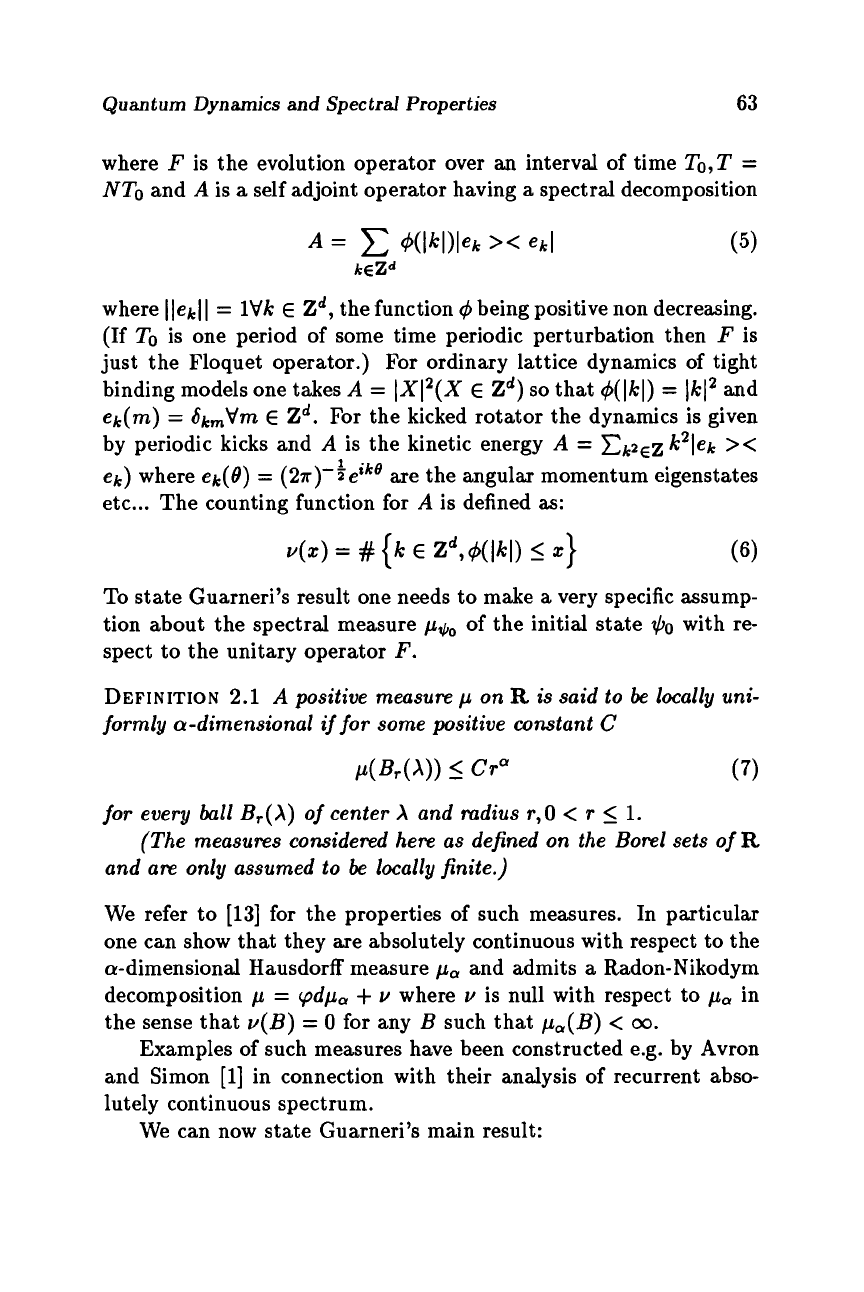
Quantum
Dynamics
and
Spectral Properties
63
where
F
is the evolution operator over an interval of time
To,T
=
NTo
and
A
is
a
self adjoint operator having
a
spectral decomposition
A
=
c
4(lkl)l.k
><
ekl
(5)
kEZd
where
llekll
=
lVk
E
Zd,
the function
4
being positive non decreasing.
(If
To
is one period of some time periodic perturbation then
F
is
just the Floquet operator.) For ordinary lattice dynamics of tight
binding models one takes
A
=
IX12(X
E
Zd)
so
that
4(
Ikl)
=
lkI2
and
ek(m)
=
Sk,Vrn
E
Zd.
For the kicked rotator the dynamics is given
by periodic kicks and
A
is the kinetic energy
A
=
&2E~k21ek
><
ek)
where
ek(0)
=
(27r)-Seeike
are the angular momentum eigenstates
etc
...
The counting function for
A
is defined
as:
1
To
state Guarneri’s result one needs to make
a
very specific assump-
tion about the spectral measure
p+,
of
the initial state
$0
with re-
spect to the unitary operator
F.
DEFINITION
2.1
A
positive measure
p
on
R
is said to
be
locally uni-
formly a-dimensional if
for
some positive constant
C
for
every
ball
Br(X)
of
center
X
and mdius
r,O
<
T
I
1.
and am only assumed to
be
locallyfinite.)
(The measures considered here as defined on the
Bore1
sets
of
R
We refer to
[13]
for the properties of such measures. In particular
one can show that they are absolutely continuous with respect to the
a-dimensional Hausdorff measure
pa
and admits
a
Radon-Nikodym
decomposition
p
=
(pdpQ
+
u
where
u
is null with respect to
pa
in
the sense that
u(B)
=
0
for any
B
such that
pa(B)
<
00.
Examples of such measures have been constructed
e.g.
by Avron
and Simon
[l]
in connection with their analysis of recurrent abso-
lutely continuous spectrum.
We can now state Guarneri’s main result:
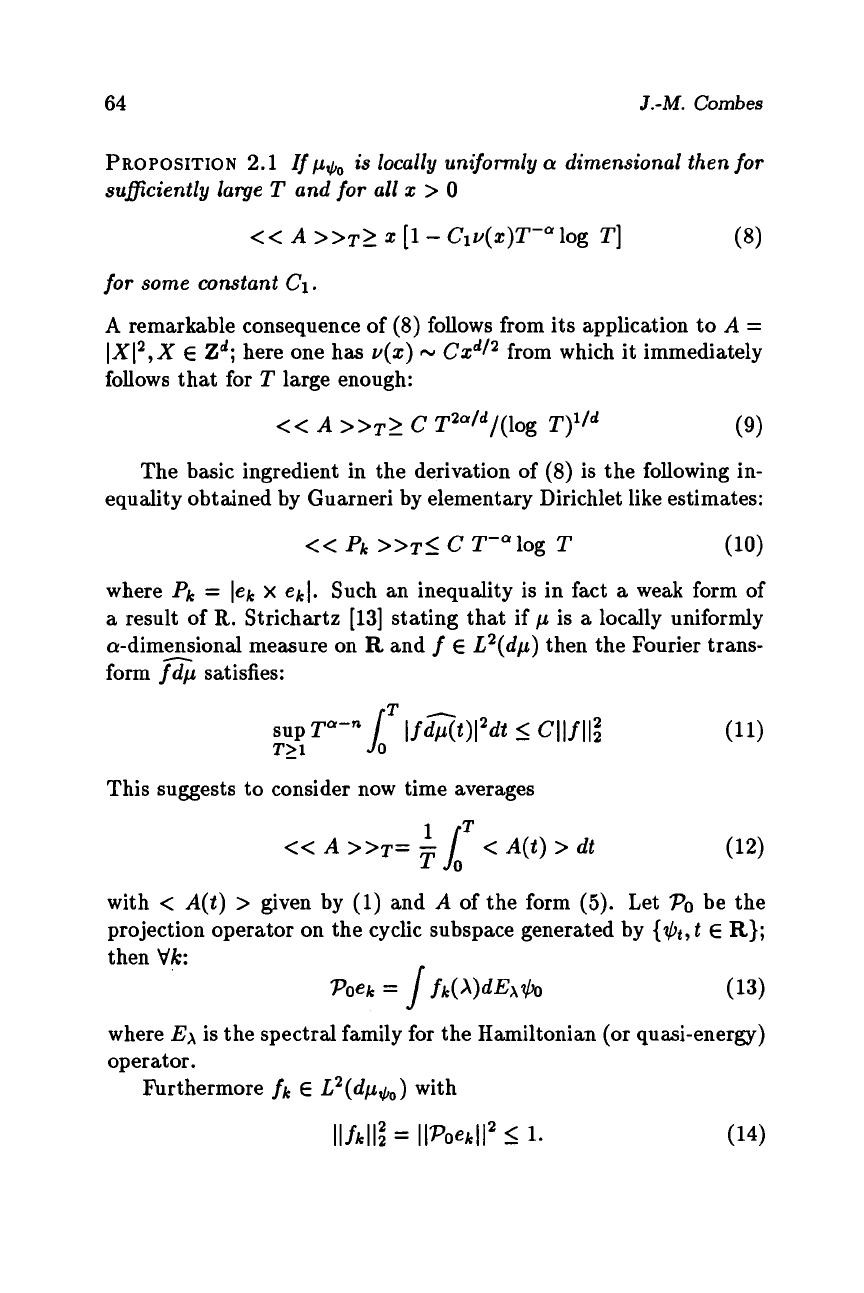
64
J.-M.
Combes
PROPOSITION
2.1
If
p,~~
is
locally uniformly
CY
dimensional then
for
suficiently large
T
and
for
all
x
>
0
<<
A
>>T?
x
[l-
C1v(x)T-alog
T]
(8)
for
some constant
C1.
A
remarkable consequence
of
(8)
follows from its application to
A
=
IXI2,X
E
Zd;
here one has v(x)
N
CxdI2 from which it immediately
follows that for
T
large enough:
<<
A
>>T>
C
TZaId/(log T)'ld
(9)
The basic ingredient in the derivation of
(8)
is the following in-
equality obtained by Guarneri by elementary Dirichlet like estimates:
<<
Pk
>>TS
c
T-Qlog
T
(10)
where
Pk
=
lek
x
ekl.
Such an inequality is in fact
a
weak form of
a
result
of
R.
Strichartz
[13]
stating that if
p
is
a
locally uniformly
a-dimensional measure
on
R
and
f
E
L2(dp)
then the Fourier trans-
form
ffp
satisfies:
This suggests to consider now time averages
<<
A
>>T=
-
<
A(t)
>
dt
(12)
LT
with
<
A(t)
>
given by
(1)
and
A
of the form
(5).
Let
PO
be the
projection operator on the cyclic subspace generated by
{?+!+,t
E
R};
then
Vk:
Pock
=
J
fk(WEA+O
(13)
where
Ex
is the spectral family for the Hamiltonian
(or
quasi-energy)
operator.
Furthermore
fk
E
L2(dp~o)
with

Quantum Dynamics and Spectral Properties
65
Since
fk&i+o(t)
=<
$'t,ek
>
inequality
(11)
implies the stronger
form of
(10):
<<
Pk
>>TI
c
T-O
(15)
From
this it follows as in
[5]
that if
p+o
is locally uniformly
a
dimen-
sional then
Vx
>
0
and
T
2
1:
<<
A
>>T>
z
[l-
C~V(X)T-"]
(16)
which is
a
generalized form of Guarneri's inequality
(8).
There is
an
obvious difficulty if one wants to apply
(16)
to the
investigation
of
quantum dynamics on
Rd
instead of
Zd
as
Guarneri
did since then
A
=
IXI2
is obviously not of the form
(5).
This can
be easily overcome if we make the extra assumption that
$0
has
bounded energy; then one has for example:
PROPOSITION
2.2
Let the quantum Hamiltonian have the
form
H
=
-A
+
V
on L2(Rd) where
V
is
real
and bounded below. Let
$0
E
V(eH)
be
such that
if
cpo
=
eH$o then
dpvo
is locally uniformly
a-
dimensional; then
for
T
2
1:
<<
/XI2
>>~2
C
T2"ld
(17)
Let us mention briefly how one can obtain
(17)
from
(16);
one has:
where
Xk
is the characteristic function of
{X
E
Rd,kj
I
Xj
<
kj
+
1,j
=
1,.
.
.
,
d}.
Then write
($t,
Xk$t)
=
(vt,
Ak(Pt)
(19)
with
(Pt
=
eH$t
and
Ak
=
e-HXke-H;
using e.g. semi-group kernel
inequalities it
is
easy to see that
Ak
is trace-class and denoting by
llAkll1
it's trace norm one has
llAkll1
5
ClleAxkeAlll
=
))eAXOeAII1
<
00
(20)
so
that
llAkll1
is uniformly bounded in
k
E
Zd.

66
J.-M.
Combes
Then
(11)
implies easily that:
sup
<<
AI,
>>TI
C
T-*llAklli
(21)
TLI
for some constant
CO
<
00.
Returning
to
(18)
one has
Va:
E
N:
<<
IX12
>>T
2
ZClnlZ>z
In12
<<
Xn
>>T
2
2
1
-
Cln12sz
1n12
<<
Xn
>>TI
2
2
I
1
-
c
dm-q
where we have used
(19)
and
(21)
in the last step; this gives
(17).
Remark:
The arguments developed above can also be used to derive
directly inequalities like
<<
(1
+
1Xl2)-'
>>T<
c
T-6
(22)
2a
d
for any
S
<
-
under the same assumptions
as
in Prop.
2.1;
details
will appear elsewhere
[2].
3
Concluding Remarks
The dependence of bounds like
(17)
or
(22)
on space dimension, in
particular in the case of absolutely continuous spectrum is somewhat
unexpected from the conventional wisdom inherited from RAGE the-
orem. However this appears
as
natural if one thinks that in disor-
dered media trajectories should look more like random walks rather
than the well-behaved asymptotic straight lines of potential scatter-
ing models which motivated Ruelle's initial work. Of course there
remains the question of whether these bounds are sharp; in partic-
ular Definition
4
of the dimension of
a
measure is somewhat am-
biguous.
As
emphasized by
S
trichartz
[
131
a-dimensional measures
with
0
<
a
<
1
need not exhibit any fractal behaviour; however if
in the Radon-Nikodym decomposition of an a-dimensional measure
with respect to Hausdorff measure
pa
the coefficient of
pa
is the
characteristic function
of
a
quasi-regular set then the upper-bound
(21)
has an associated related lower-bound. This is enough to get
directly lower-bounds e.g.
for
<<
(1
+
IX(2)-y
>>T
for
y
>
4.
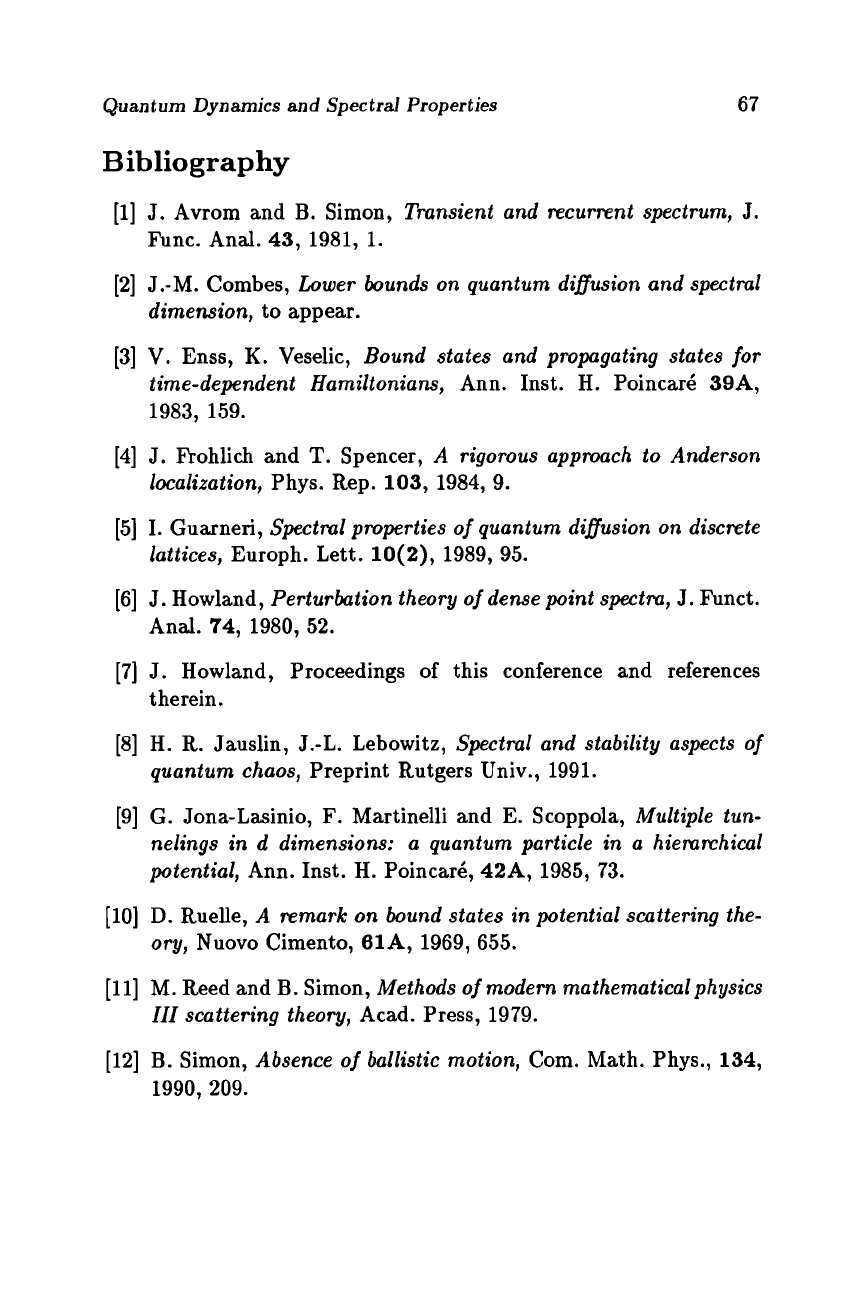
Quantum Dynamics and Spectral Properties
67
Bibliography
[l]
J.
Avrom and
B.
Simon,
Transient and recurrent spectrum,
J.
Func. Anal.
43,
1981, 1.
[2]
J.-M. Combes,
Lower bounds on quantum diflusion and spectral
dimension,
to appear.
[3]
V. Enss,
K.
Veselic,
Bound states and propagating states for
time-dependent Hamiltonians,
Ann. Inst.
H.
Poincarb
39A,
1983, 159.
[4]
J. F'rohlich and
T.
Spencer,
A
rigorous
approach to Anderson
localization,
Phys. Rep.
103,
1984, 9.
[5]
I.
Guaxneri,
Spectral properties
of
quantum diflusion on discrete
lattices,
Europh. Lett.
10(2),
1989, 95.
[6]
J.
Howland,
Perturbation theory
of
dense point spectra,
J. Funct.
Anal.
74,
1980, 52.
[7]
J. Howland, Proceedings of this conference and references
therein.
[8]
H.
R. Jauslin, J.-L. Lebowitz,
Spectral and stability aspects
of
quantum chaos,
Preprint Rutgers Univ.,
1991.
[9]
G. Jona-Lasinio,
F.
Martinelli and E. Scoppola,
Multiple tun-
nelings in
d
dimensions:
a
quantum particle in
a
hierarchical
potential,
Ann. Inst.
H.
Poincarb,
42A,
1985, 73.
[lo]
D.
Ruelle,
A
remark on bound states in potential scattering the-
ory,
Nuovo Cimento,
61A,
1969, 655.
[ll]
M.
Reed and
B.
Simon,
Methods
of
modern mathematicalphysics
111
scattering theory,
Acad. Press,
1979.
[12]
B.
Simon,
Absence
of
ballistic motion,
Com. Math. Phys.,
134,
1990,209.
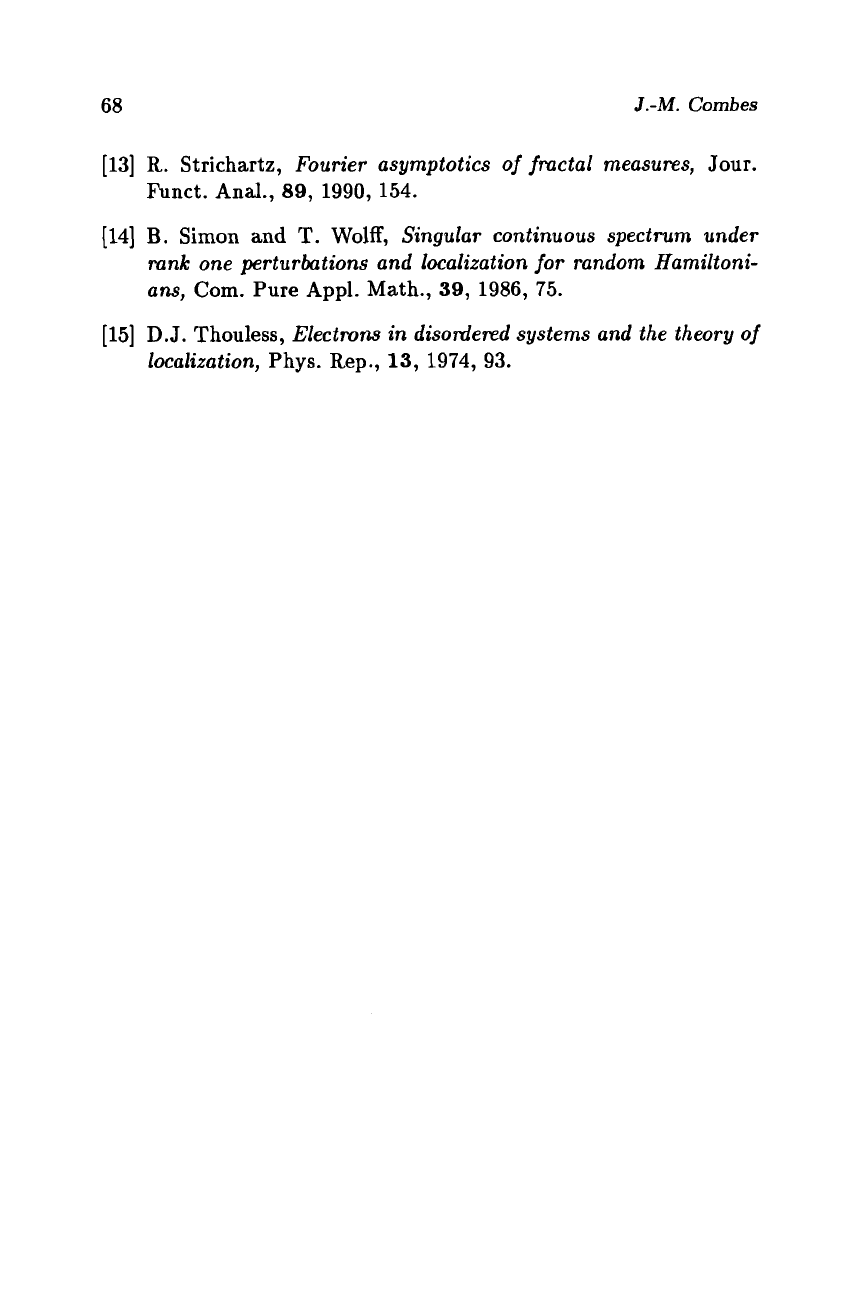
68
J.-M.
Combes
[13]
R.
Strichartz,
Fourier asymptotics
of
fractal measures,
Jour.
F’unct. Anal.,
89,
1990, 154.
[14]
B.
Simon
and
T.
Wolff,
Singular continuous spectrum under
rank one perturbations and localization
for
random Hamiltoni-
am,
Corn.
Pure
Appl. Math.,
39,
1986, 75.
[15]
D.J.
Thouless,
EZectrons in disordered systems and the theory
of
localization,
Phys.
Rep.,
13,
1974, 93.
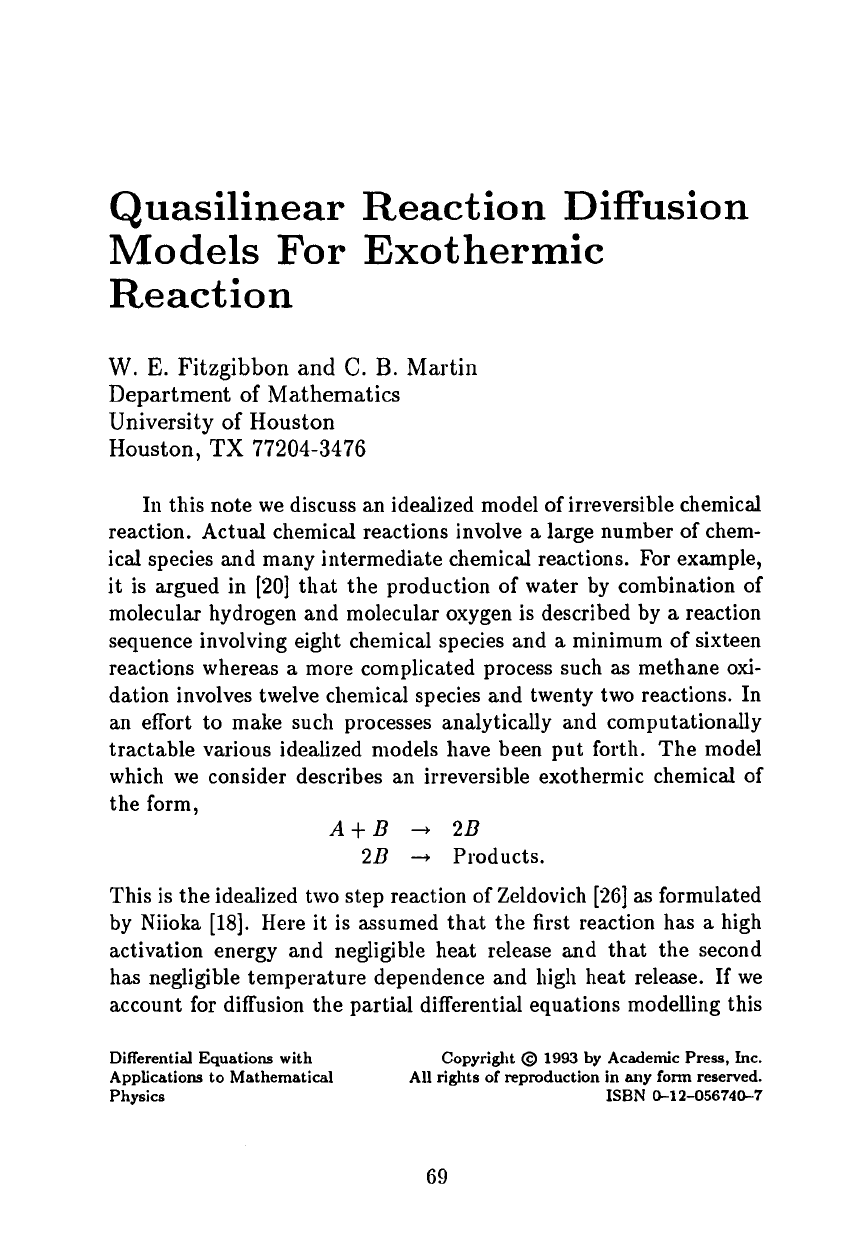
Quasilinear
Reaction Diffusion
Models
For
Exothermic
Reaction
W.
E.
Fitzgibbon and
C.
B.
Martin
Department
of
Mathematics
University
of
Houston
Houston,
TX
77204-3476
In this note we discuss an idealized model of irreversible chemical
reaction. Actual chemical reactions involve
a
large number
of
chem-
ical species and many intermediate chemical reactions.
For
example,
it is argued in
[20]
that the production of water by combination of
molecular hydrogen and molecular oxygen is described by
a
reaction
sequence involving eight chemical species and
a
minimum of sixteen
reactions whereas
a
more complicated process such as methane
oxi-
dation involves twelve chemical species and twenty two reactions. In
an effort to make such processes analytically and computationally
tractable various idealized models have been put forth. The model
which we consider describes an irreversible exothermic chemical
of
the form,
A+B
--f
2B
213
--+
Products.
This is the idealized two step reaction
of Zeldovich
[2G]
as formulated
by Niioka
[18].
Here it is assumed that the first reaction has
a
high
activation energy and negligible heat release and that the second
has negligible temperature dependence and high heat release. If we
account for diffusion the partial differential equations modelling this
Differential Equations with Copyright
@
1993
by
Academic Press, Inc.
Applications
to
Mat hemat ical All rights
of
reproduction in
any
form
reserved.
Physics
ISBN
0-12-056740-7
